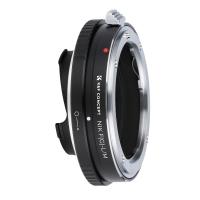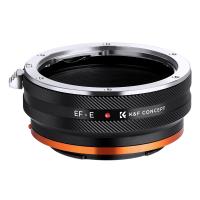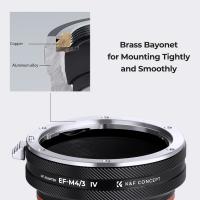When Was The Electron Microscope Discovered ?
The electron microscope was discovered in 1931.
1、 Development of early electron microscopy techniques (1920s-1930s)
The electron microscope, a powerful tool that revolutionized the field of microscopy, was developed in the 1920s and 1930s. The discovery of the electron microscope can be attributed to the work of several scientists who made significant contributions to the development of early electron microscopy techniques.
One of the key figures in the development of the electron microscope was Ernst Ruska, a German physicist. In 1931, Ruska built the first electron microscope, which used a magnetic coil to focus a beam of electrons onto a specimen. This allowed for much higher magnification and resolution compared to traditional light microscopes. Ruska's work laid the foundation for the future development of electron microscopy.
Another important contributor to the field was Max Knoll, a German electrical engineer. In collaboration with Ernst Ruska, Knoll developed the first practical electron microscope in 1932. This microscope was capable of producing clear images of biological specimens and paved the way for further advancements in electron microscopy.
Over the years, electron microscopy techniques have continued to evolve and improve. Modern electron microscopes can achieve magnifications of up to several million times and provide detailed information about the structure and composition of materials at the atomic level. In recent years, advancements in electron microscopy have led to breakthroughs in various scientific fields, including materials science, biology, and nanotechnology.
In conclusion, the electron microscope was discovered and developed in the 1920s and 1930s by scientists such as Ernst Ruska and Max Knoll. Their pioneering work laid the foundation for the development of modern electron microscopy techniques, which have revolutionized our understanding of the microscopic world.

2、 Invention of the first practical electron microscope (1931)
The electron microscope, a revolutionary tool that has transformed our understanding of the microscopic world, was invented in 1931. The credit for this groundbreaking invention goes to Ernst Ruska, a German physicist, who developed the first practical electron microscope along with his colleague Max Knoll.
The electron microscope operates on the principle of using a beam of electrons instead of light to magnify objects. This allows for much higher magnification and resolution compared to traditional light microscopes. The electron microscope has played a crucial role in various scientific fields, including biology, materials science, and nanotechnology.
Since its discovery, the electron microscope has undergone significant advancements and improvements. In recent years, there have been remarkable developments in electron microscopy techniques, leading to even higher resolution and more detailed imaging. For example, the introduction of scanning electron microscopy (SEM) and transmission electron microscopy (TEM) has allowed scientists to study the surface and internal structures of specimens with unprecedented clarity.
Furthermore, advancements in electron microscope technology have enabled the study of dynamic processes at the atomic level. Techniques such as cryo-electron microscopy (cryo-EM) have revolutionized the field of structural biology, allowing scientists to visualize biomolecules in their native state. This has led to significant breakthroughs in understanding the structure and function of proteins and other biological macromolecules.
In recent years, there has also been a growing interest in the development of electron microscopy techniques for materials characterization and analysis. Electron energy loss spectroscopy (EELS) and electron diffraction techniques have provided valuable insights into the properties and behavior of materials at the atomic scale.
Overall, the discovery of the electron microscope in 1931 marked a significant milestone in scientific research. Since then, continuous advancements in electron microscopy techniques have expanded our knowledge and opened up new avenues for exploration in various scientific disciplines.

3、 Advancements in electron microscope resolution and imaging capabilities (1940s-1950s)
The electron microscope, a powerful tool that revolutionized the field of microscopy, was discovered in the 1940s-1950s. During this time, significant advancements were made in electron microscope resolution and imaging capabilities.
The concept of the electron microscope was first proposed by German physicist Ernst Ruska in 1931. However, it wasn't until the 1940s that Ruska, along with his collaborator Max Knoll, successfully built the first electron microscope. This groundbreaking invention allowed scientists to observe objects at a much higher resolution than was possible with traditional light microscopes.
Advancements in electron microscope resolution and imaging capabilities continued throughout the 1940s and 1950s. In 1942, James Hillier and Albert Prebus developed the first practical scanning electron microscope (SEM), which provided detailed three-dimensional images of the surface of specimens. This was a significant improvement over the transmission electron microscope (TEM), which only provided two-dimensional images.
In the 1950s, further developments were made to improve the resolution and imaging capabilities of electron microscopes. Ernst Ruska, along with his brother Helmut, introduced the concept of the field emission electron microscope (FE-SEM) in 1951. This type of microscope used a sharp needle-like emitter to produce a highly focused electron beam, resulting in even higher resolution images.
Since the 1950s, electron microscope technology has continued to advance. Modern electron microscopes can now achieve resolutions down to the atomic level, allowing scientists to study the intricate details of materials and biological specimens. Additionally, advancements in computer technology have enabled the development of sophisticated imaging techniques, such as cryo-electron microscopy, which has revolutionized the field of structural biology.
In conclusion, the electron microscope was discovered in the 1940s-1950s, with significant advancements in resolution and imaging capabilities during this time. Since then, electron microscopy has continued to evolve, providing scientists with a powerful tool for exploring the microscopic world.

4、 Introduction of transmission electron microscopy (TEM) and scanning electron microscopy (SEM)
The electron microscope, a revolutionary tool in the field of microscopy, was discovered in the early 20th century. The introduction of transmission electron microscopy (TEM) and scanning electron microscopy (SEM) marked a significant milestone in the advancement of scientific research and our understanding of the microscopic world.
The discovery of the electron microscope can be attributed to the work of German physicist Ernst Ruska and his mentor Max Knoll. In 1931, Ruska and Knoll successfully built the first TEM, which used a beam of electrons instead of light to magnify specimens. This breakthrough allowed scientists to observe objects at a much higher resolution than was previously possible with traditional light microscopes.
In the following years, the SEM was developed by Manfred von Ardenne in Germany and Charles Oatley in the United Kingdom. The SEM uses a different approach, scanning a focused beam of electrons across the surface of a specimen to create a detailed image. This technique provides a three-dimensional view of the specimen, allowing for a deeper understanding of its structure and composition.
Since their discovery, TEM and SEM have become indispensable tools in various scientific disciplines, including biology, materials science, and nanotechnology. They have enabled researchers to study the intricate details of cells, viruses, and nanoparticles, leading to groundbreaking discoveries and advancements in these fields.
In recent years, there have been significant advancements in electron microscopy technology. For example, the development of aberration-corrected electron microscopy has allowed for even higher resolution imaging, pushing the boundaries of what can be observed at the atomic scale. Additionally, the integration of electron microscopy with other techniques, such as spectroscopy and tomography, has further expanded the capabilities of these instruments.
In conclusion, the electron microscope, with the introduction of TEM and SEM, was discovered in the early 20th century. Since then, it has revolutionized scientific research by providing unprecedented resolution and depth of information. With ongoing advancements, electron microscopy continues to play a crucial role in expanding our knowledge of the microscopic world.






































